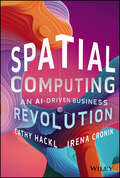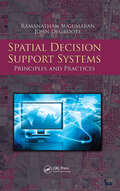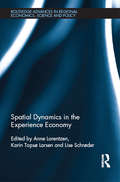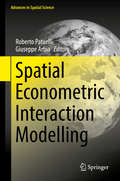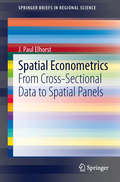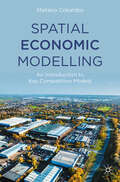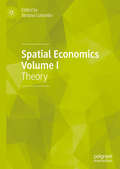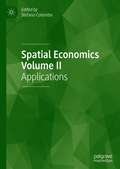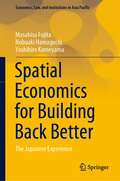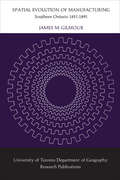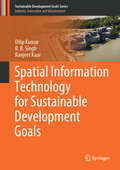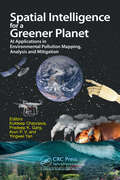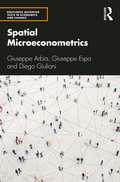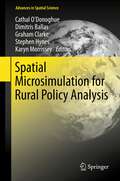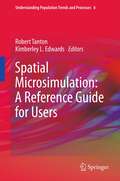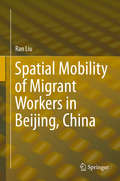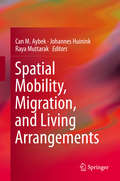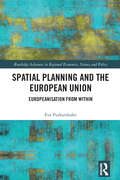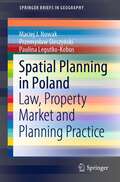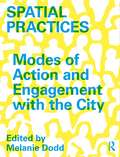- Table View
- List View
Spatial Agency: Other Ways of Doing Architecture
by Nishat Awan Tatjana Schneider Jeremy TillThis book offers the first comprehensive overview of alternative approaches to architectural practice. At a time when many commentators are noting that alternative and richer approaches to architectural practice are required if the profession is to flourish, this book provides multiple examples from across the globe of how this has been achieved and how it might be achieved in the future. Particularly pertinent in the current economic climate, this book offers the reader new approaches to architectural practice in a changing world. It makes essential reading for any architect, aspiring or practicing.
Spatial Computing: An AI-Driven Business Revolution
by Irena Cronin Cathy HacklThe next phase of the internet—multimodal, vision-enabled AI that will transform society Written by Irena Cronin, renowned consultant in the immersive space, and Cathy Hackl, globally recognized tech & gaming executive, futurist, and speaker, Spatial Computing: An AI-Driven Business Revolution reveals exclusive insider knowledge of what's happening today in the convergence of AI and spatial computing. Spatial Computing is an evolving 3D-centric form of computing that uses AI, Computer Vision, and extended reality to blend virtual experiences into the physical world, breaking free from screens into everything you can see, experience, and know. Spatial Computing: An AI-Driven Business Revolution includes coverage of: The new paradigm of human-to-human and human-computer interaction, enhancing how we visualize, simulate, and interact with data in physical and virtual locations Navigating the world alongside robots, drones, cars, virtual assistants, and beyond—without the limitation of just one technology or device Insights, tools and illustrative use cases that enable businesses to harness the convergence of AI and spatial computing today and in the decade to come via both hardware and software The impact of spatial computing is just starting to be felt. Spatial Computing: An AI-Driven Business Revolution is a must-have resource for business leaders who wish to fully understand this new form of revolutionary, evolutionary technology that is expected to be even more impactful than personal computing and mobile computing.
Spatial Data Analysis: Models, Methods and Techniques
by Jinfeng Wang Manfred M. FischerThe availability of spatial databases and widespread use of geographic information systems has stimulated increasing interest in the analysis and modelling of spatial data. Spatial data analysis focuses on detecting patterns, and on exploring and modelling relationships between them in order to understand the processes responsible for their emergence. In this way, the role of space is emphasised , and our understanding of the working and representation of space, spatial patterns, and processes is enhanced. In applied research, the recognition of the spatial dimension often yields different and more meaningful results and helps to avoid erroneous conclusions. This book aims to provide an introduction into spatial data analysis to graduates interested in applied statistical research. The text has been structured from a data-driven rather than a theory-based perspective, and focuses on those models, methods and techniques which are both accessible and of practical use for graduate students. Exploratory techniques as well as more formal model-based approaches are presented, and both area data and origin-destination flow data are considered.
Spatial Decision Support Systems: Principles and Practices
by Ramanathan Sugumaran John DegrooteThis book provides a comprehensive examination of the various aspects of SDSS evolution, components, architecture, and implementation. Integrating research from a variety of disciplines, it supplies a complete overview of SDSS technologies and their application. This groundbreaking reference provides thorough coverage of the roots of SDSS. It explains the core principles of SDSS, how to use them in various decision making contexts, and how to design and develop them using readily available enabling technologies and commercial tools.
Spatial Dynamics in the Experience Economy (Routledge Advances in Regional Economics, Science and Policy)
by Anne Lorentzen Karin Topsø Larsen Lise SchrøderThis book explores the dynamics of place, location and territories from the perspective of an experience-based economy. It offers a valuable contribution to this new approach and the planning and management challenges it faces. This book emphasises three key avenues to understanding the experience economy. First, the book reconsiders innovation processes and the relationship between the consumption and production of experience value. Second, it considers emerging forms of governance related to experience-based development in businesses and cities. Third, it examines the role of place as a value, resource and outcome of experiential innovation and planning. This book will be of interested to researchers concerned with urban and regional development.
Spatial Econometric Interaction Modelling
by Roberto Patuelli Giuseppe ArbiaThis contributed volume applies spatial and space-time econometric methods to spatial interaction modeling. The first part of the book addresses general cutting-edge methodological questions in spatial econometric interaction modeling, which concern aspects such as coefficient interpretation, constrained estimation, and scale effects. The second part deals with technical solutions to particular estimation issues, such as intraregional flows, Bayesian PPML and VAR estimation. The final part presents a number of empirical applications, ranging from interregional tourism competition and domestic trade to space-time migration modeling and residential relocation.
Spatial Econometrics
by J. Paul ElhorstThis book provides an overview of three generations of spatial econometric models: models based on cross-sectional data, static models based on spatial panels and dynamic spatial panel data models. The book not only presents different model specifications and their corresponding estimators, but also critically discusses the purposes for which these models can be used and how their results should be interpreted.
Spatial Economic Modelling: An Introduction to Key Competition Models
by Stefano ColomboThis textbook provides an accessible introduction to spatial competition models in economics. It shows students how to understand and apply spatial models to analysis of market design, structure, competition and pricing. The book aims to provide a step-by-step guide to learning and implementing spatial modelling. It provides a concise history of the spatial approach and a self-contained primer chapter on the key game theory tools required to undertake spatial analysis. It then provides a comprehensive explanation of the key traditions and models, including the Hotelling model and related Salop circle model, and demonstrates their various applications to consumer, firm and market interactions. Topics covered in the book include: product differentiation, the physical location of firms, spatial price discrimination, oligopolistic competition, non-uniform distributions of consumers, political competition and the basic Downs model, and the application of spatial models to marketing and management. This book will be a valuable resource for undergraduate students in microeconomics and applied economics, particularly on industrial organization courses.
Spatial Economics Volume I: Theory
by Stefano ColomboSpace is a crucial variable in any economic activity. Spatial Economics is the branch of economics that explicitly aims to incorporate the space dimension in the analysis of economic phenomena. From its beginning in the last century, Spatial Economics has contributed to the understanding of the economy by developing plenty of theoretical models as well as econometric techniques having the “space” as a core dimension of the analysis. This edited volume addresses the complex issue of Spatial Economics from a theoretical point of view. This volume is part of a more complex project including another edited volume (Spatial Economics Volume II: Applications) collecting original papers which address Spatial Economics from an applied perspective.
Spatial Economics Volume II: Applications
by Stefano ColomboSpace is a crucial variable in any economic activity. Spatial Economics is the branch of economics that explicitly aims to incorporate the space dimension in the analysis of economic phenomena. From its beginning in the last century, Spatial Economics has contributed to the understanding of the economy by developing plenty of theoretical models as well as econometric techniques having the “space” as a core dimension of the analysis.This edited volume addresses the complex issue of Spatial Economics from an applied point of view. This volume is part of a more complex project including another edited volume (Spatial Economics Volume I: Theory) collecting original papers which address Spatial Economics from a theoretical perspective.
Spatial Economics for Building Back Better: The Japanese Experience (Economics, Law, and Institutions in Asia Pacific)
by Masahisa Fujita Nobuaki Hamaguchi Yoshihiro KameyamaThe central theme of this book is national land and infrastructure design in the age of the declining population and the recovery from the Great East Japan Earthquake in the affected regions in Japan. Based on the theory of spatial economics and evidence from Japanese history, the authors show that the growing economy with a population increase develops into a multi-cored and complex structure. In the population decline phase, however, such construction will be destabilized because of agglomeration economies in the central core. Then, a catastrophic shock that strikes may provoke the decline of the lower-rank-size provincial cities and their eventual disappearance if they compete only in lower prices of staple products. Not only is the practice bad for the residents; it also leads to lower national welfare resulting from the loss of diversity and overcrowded big cities. The authors argue that small local towns can recover and will be sustained if they will endeavor in innovative production by making good use of local natural resources and social capital. Under the ongoing declining population in Japan, an undesirable concentration in Tokyo will proceed further with increasing social cost and risk. The recent novel coronavirus pandemic has highlighted that concern.
Spatial Evolution of Manufacturing: Southern Ontario 1851-1891
by James M. GilmourEuropeans who settled previously unpopulated and unexploited regions of the world during the 18th and 19th centuries of the world had two economic alternatives: subsistence activities or the production of primary goods for export. In general the latter prevailed and the landscape and economy were transformed. This study examines industrial growth in Southern Ontario, one of the most economically successful regions, from 1851-1891, a period when primary activities were still very important but also when today's industrial structure was clearly being shaped. Economists, geographers, and those in related fields will welcome this approach which unites regional economic growth theory, and an empirical examination of distributional and structural change in manufacturing, in a general explanation of the spatial development of manufacturing that is relevant to all export-based regions.
Spatial Information Technology for Sustainable Development Goals (Sustainable Development Goals Series)
by Dilip Kumar R.B. Singh Ranjeet KaurThis textbook aims to develop a scientific knowledge base on spatial information technology to communicate the United Nations' Sustainable Development Goals (SDGs) among students, researchers, professionals and laymen. The book improves understanding of the spatial database and explains how to extract information from this for planning purposes. To enhance the knowledge of geoscientists and environmentalists, the book describes the basic fundamental concepts to advance techniques for spatial data management and analysis and discusses the methodology. The Geographic Information System (GIS), remote sensing and Global Positioning System (GPS) are presented in an integrated manner for the planning of resources and infrastructure. The management of these systems is discussed in a very lucid way to develop the reader's skills. The proper procedure for map making and spatial analysis are included along with case studies to the reader. Where the first part of the book discusses the conceptual background, the second part deals with case studies using these applications in different disciplines. The presented case studies include land use, agriculture, flood, watershed characterization and infrastructure assessment for the Sustainable Development Goals.
Spatial Intelligence for a Greener Planet: AI Applications in Environmental Pollution Mapping, Analysis and Mitigation
by Pradeep K. Garg Kuldeep Chaurasia P. V. Arun Yingwei YanWith rapid advancements in AI, this book reveals how AI can be a powerful tool in reducing pollution and fostering sustainability. It highlights the integration of geospatial techniques with AI for enhancing capabilities in mapping, analysis, and mitigation of environmental pollution. Starting with foundational concepts in AI, geospatial technology, and pollution, the book addresses air, water, soil and thermal pollution, emphasizing their harmful impacts. Through real-world case studies and advanced research, it showcases AI and geospatial technology's revolutionary role in pollution mitigation, exploring AI-driven sensors, satellite imagery, and associated networks for precise and efficient pollution monitoring and management.
Spatial Interaction Models with Land Use: A Tool for Interdisciplinary Analysis and Integrated Territorial Policy (Contributions to Regional Science)
by Tomaz Ponce Dentinho Paulo SilveiraThis book develops spatial interaction models for the analysis of human interaction within space, in terms of both accessibility and land use. Presenting case studies on the Azores and Morocco, it covers applications in various regions of Europe and Africa. The respective models simulate land use, employment, households, commuting and shopping movements and land values, employment distribution for basic activities, changes in accessibility, and changes in land suitability due to climate change.This book will appeal to scholars and students of regional and spatial science, ecological economics, and agricultural economics, as well as to spatial planners and practitioners dealing with issues of spatial planning to address such problems as unsustainable land use, adaptation to climate change, desertification of rural areas heavily dependent on land use, and the impacts of external shocks on land and property values.
Spatial Justice and Cohesion: The Role of Place-Based Action in Community Development (ISSN)
by James W. Scott Matti Fritsch Petri Kahila Sarolta NémethPlace-based strategies are widely discussed as powerful instruments of economic and community development. In terms of the European debate, the local level – cities, towns and neighbourhoods – has recently come under increased scrutiny as a potentially decisive actor in Cohesion Policy. As understandings of socio-spatial and economic cohesion evolve, the idea that spatial justice requires a concerted policy response has gained currency.Given the political, social and economic salience of locale, this book explores the potential contribution of place-based initiative to more balanced and equitable socio-economic development, as well as growth in a more general sense. The overall architecture of the book and the individual chapters address place-based perspectives from a number of vantage points, including the potential of achieving greater effectiveness in EU and national level development policies, through a greater local level and citizens' role and concrete actions for achieving this; enhancing decision-making autonomy by pooling local capacities for action; linking relative local autonomy to development outcomes and viewing spatial justice as a concept and policy goal. The book highlights, through the use of case studies, how practicable and actionable knowledge can be gained from local development experiences.This book targets researchers, practitioners and students who seek to learn more about place-based based development and its potentials. Its cross-cutting focus on spatial justice and place will ensure that the book is of wider international interest.The Open Access version of this book, available at www.taylorfrancis.com, has been made available under a Creative Commons Attribution-Non Commercial-No Derivatives (CC-BY-NC-ND) 4.0 license. Funded by The University of Eastern Finland.
Spatial Justice and Cohesion: The Role of Place-Based Action in Community Development (Regions and Cities)
by James W. Scott Matti Fritsch Petri Kahila Sarolta NémethPlace-based strategies are widely discussed as powerful instruments of economic and community development. In terms of the European debate, the local level – cities, towns and neighbourhoods – has recently come under increased scrutiny as a potentially decisive actor in Cohesion Policy. As understandings of socio-spatial and economic cohesion evolve, the idea that spatial justice requires a concerted policy response has gained currency. Given the political, social and economic salience of locale, this book explores the potential contribution of place-based initiative to more balanced and equitable socio-economic development, as well as growth in a more general sense. The overall architecture of the book and the individual chapters address place-based perspectives from a number of vantage points, including the potential of achieving greater effectiveness in EU and national level development policies, through a greater local level and citizens' role and concrete actions for achieving this; enhancing decision-making autonomy by pooling local capacities for action; linking relative local autonomy to development outcomes and viewing spatial justice as a concept and policy goal. The book highlights, through the use of case studies, how practicable and actionable knowledge can be gained from local development experiences. This book targets researchers, practitioners and students who seek to learn more about place-based based development and its potentials. Its cross-cutting focus on spatial justice and place will ensure that the book is of wider international interest.
Spatial Microeconometrics (Routledge Advanced Texts in Economics and Finance)
by Giuseppe Arbia Giuseppe Espa Diego GiulianiSpatial Microeconometrics introduces the reader to the basic concepts of spatial statistics, spatial econometrics and the spatial behavior of economic agents at the microeconomic level. Incorporating useful examples and presenting real data and datasets on real firms, the book takes the reader through the key topics in a systematic way. The book outlines the specificities of data that represent a set of interacting individuals with respect to traditional econometrics that treat their locational choices as exogenous and their economic behavior as independent. In particular, the authors address the consequences of neglecting such important sources of information on statistical inference and how to improve the model predictive performances. The book presents the theory, clarifies the concepts and instructs the readers on how to perform their own analyses, describing in detail the codes which are necessary when using the statistical language R. The book is written by leading figures in the field and is completely up to date with the very latest research. It will be invaluable for graduate students and researchers in economic geography, regional science, spatial econometrics, spatial statistics and urban economics.
Spatial Microsimulation for Rural Policy Analysis
by Cathal O'Donoghue Stephen Hynes Karyn Morrissey Graham Clarke Dimitris BallasThe aim of this book is to explore the challenges facing rural communities and economies and to demonstrate the potential of spatial microsimulation for policy and analysis in a rural context. This is done by providing a comprehensive overview of a particular spatial microsimulation model called SMILE (Simulation Model of the Irish Local Economy). The model has been developed over a ten year period for applied policy analyis in Ireland which is seen as an ideal study area given its large percentage of population living in rural areas. The book reviews the policy context and the state of the art in spatial microsimulation against which SMILE was developed, describes in detail its model design and calibration, and presents example of outputs showing what new information the model provides using a spatial matching process. The second part of the book explores a series of rural issues or problems, including the impacts of new or changing government or EU policies, and examines the contribution that spatial microsimulation can provide in each area.
Spatial Microsimulation: A Reference Guide for Users
by Kimberley Edwards Robert TantonThis book is a practical guide on how to design, create and validate a spatial microsimulation model. These models are becoming more popular as academics and policy makers recognise the value of place in research and policy making. Recent spatial microsimulation models have been used to analyse health and social disadvantage for small areas; and to look at the effect of policy change for small areas. This provides a powerful analysis tool for researchers and policy makers. This book covers preparing the data for spatial microsimulation; a number of methods for both static and dynamic spatial microsimulation models; validation of the models to ensure the outputs are reasonable; and the future of spatial microsimulation. The book will be an essential handbook for any researcher or policy maker looking to design and create a spatial microsimulation model. This book will also be useful to those policy makers who are commissioning a spatial microsimulation model, or looking to commission work using a spatial microsimulation model, as it provides information on the different methods in a non-technical way.
Spatial Mobility of Migrant Workers in Beijing, China
by Ran LiuThe great migration of farmers leaving rural China to work and live in big cities as 'floaters' has been an on-going debate in China for the past three decades. This book probes into the spatial mobility of migrant workers in Beijing, and questions the city 'rights' issues beneath the city-making movement in contemporary China. In revealing and explaining the socio-spatial injustice, this volume re-theorizes the 'right to the city' in the Chinese context since Deng Xiaoping's reforms. The policy review, census analysis, and housing survey are conducted to examine the fate of migrant workers, who being the most marginalized group have to move persistently as the city expands and modernizes itself. The study also compares the migrant workers with local Pekinese dislocated by inner city renewals and city expansion activities. Rapid urban growth and land expropriation of peripheral farmlands have also created a by-product of urbanization, an informal property development by local farmers in response to rising low-cost rental housing demand. This is a highly comparable phenomenon with cities in other newly industrialized countries, such as São Paulo. Readers will be provided with a good basis in understanding the interplay as well as conflicts between migrant workers' housing rights and China's globalizing and branding pursuits of its capital city. Audience: This book will be of great interest to researchers and policy makers in housing planning, governance towards urban informalities, rights to the city, migrant control and management, and housing-related conflict resolutions in China today.
Spatial Mobility, Migration, and Living Arrangements
by Can M. Aybek Johannes Huinink Raya MuttarakThis book brings together ten original empirical works focusing on the influence of various types of spatial mobility - be it international or national- on partnership, family and work life. The contributions cover a range of important topics which focus on understanding how spatial mobility is related to familial relationships and life course transitions. The volume offers new insights by bringing together the state of the art in theoretical and empirical approaches from spatial mobility and international migration research. This includes, for example, studies that investigate the relationships between international migration and changing patterns of partnership choice, family formation and fertility. Complementing to this, this volume presents new empirical studies on job-related residential mobility and its impact on the relationship quality of couples, family life, and union dissolution. It also highlights the importance of research that looks at the reciprocal relationships between mobility and life course events such as young adults leaving the parental home in international migration context, re-arrangements of family life after divorce and spatial mobility of the elderly following life transitions. The scholarly work included in this volume does not only contribute to theoretical debates but also provide timely empirical evidence from various societies which represent the common features in the dynamics of spatial mobility and migration.
Spatial Planning and the European Union: Europeanisation from Within (Routledge Advances in Regional Economics, Science and Policy)
by Eva PurkarthoferEuropean Union policies are intertwined with all sectors of public administration and governance in the member states, including spatial, urban and regional planning. Legal regulations like the Natura 2000 Directives, funding programmes associated with EU Cohesion Policy or strategies such as the Territorial Agenda 2030 all leave their mark on planning – yet with considerably different effects in Europe’s cities and regions.This book serves as a guide to navigate the connection points between EU policies and spatial planning by introducing the logics of EU policymaking and European spatial planning, outlining the most important EU policies with relevance for spatial planning and presenting examples, from Austria and Finland, of how EU policies are applied in domestic contexts. By exploring the Europeanisation of spatial planning ‘from within’, the book acknowledges how differential ideas about what spatial planning is and what role the EU plays therein shape the actualised impacts of EU policies.By providing a comprehensive perspective on the relevance of the European Union for spatial planning, this book is ideal for students, academics and administrators who want to grasp how the EU shapes and affects planning practice in Europe’s cities and regions.
Spatial Planning in Poland: Law, Property Market and Planning Practice (SpringerBriefs in Geography)
by Maciej J. Nowak Przemysław Śleszyński Paulina Legutko-KobusThis book defines the dilemmas related to the interface between legal regulations and planning practice in the spatial management system. Based on specific case studies, it gives examples of possible problems and ways of solving them. It applies to Poland's standard and the determinants of spatial policy in other countries. It provides the basis for a developed international discussion and concretely suggests specific actions at local, regional and national levels.
Spatial Practices: Modes of Action and Engagement with the City
by Melanie DoddThis book explores ‘spatial practices’, a loose and expandable set of approaches that embrace the political and the activist, the performative and the curatorial, the architectural and the urban. Acting upon and engaging with the public realm, the field of spatial practices allows people to reconnect with their own sense of agency through engagement in space and place, exploring and prototyping alternative futures in the here and now. The 24 chapters contain essays, visual essays and interviews, featuring contributions from an international set of experimental practitioners including Jeanne van Heeswijk (Netherlands), Teddy Cruz (Estudio Teddy Cruz + Fonna Forman, San Diego), Hector (USA), The Decorators (London) and OOZE (Netherlands). Beautifully designed with full colour illustrations, Spatial Practices advances dialogue and collaboration between academics and practitioners and is essential reading for students, researchers and professionals in architecture, urban planning and urban policy.

